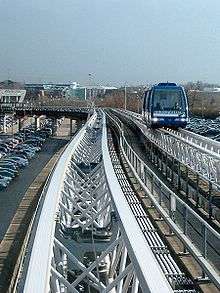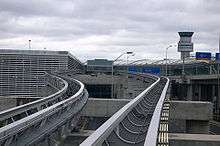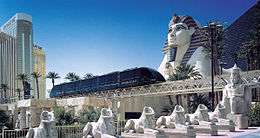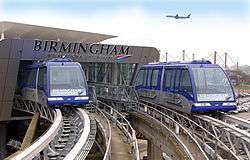Cable Liner
The Cable Liner and Cable Liner Shuttle is a range of automated people mover (APM) products designed by DCC Doppelmayr Cable Car for use at airports, in city centers, intermodal passenger transport connections, park and ride facilities, campuses, resorts and amusement parks.

The design is notable for superseding the maglev transport system at Birmingham International Airport which was, at the time, the world’s only commercial maglev system. The technology was used for the new "AirRail Link" on the existing maglev guideway to replace the previous system and temporary bus-service shuttle that had been operating in the meantime.[1]
Technology and system features
The automated people mover (APM) systems are based on cable-propelled technology. Distances up to 4 km (2.5 mi) and a peak passenger flow of up to 7,000 pphpd (people per hour per direction) are possible.[2]
Cable propelled

In a cable-propelled APM system, a central station powers the system. A fixed grip assembly connects the train to the cable.[3] The cable propels, accelerates, decelerates and brakes the train.[3] The train has no on-board drive engines, gearboxes or brakes.
Fully automated

Because the system is automated, there are no drivers, conductors or on-board operators. The system operation is monitored from a central control room. Remote equipment diagnosis, by means of a telecommunication link, is possible.[4]
Evacuation system
The evacuation system is based on an independent stationary Diesel emergency drive that would pull a stranded train back to the station, eliminating the need for an emergency walkway. Trains like these can be also used for different purposes, such as moving trailers and barge loaders.
Train vehicles

The train's drive machinery is isolated from the train environment, therefore, noise levels along the track and in the station platforms are very low and there are no emissions.
Guideway

The APM uses a self-supporting steel guideway. It is a light steel guideway, which is possible because of the use of lighter trains. The track consists of an I-beam which forms the running and guiding surface.[5] The guideway superstructure is a steel framework construction. The guideway does not require heating in harsh winter conditions.[5] Steel adapters between the steel truss guideway and the concrete columns allow height adjustments to compensate for ground settlements.[6] The track can span more than 67 m (220 ft).
Design

The train has same look either way it is operated. The middle cars are identical and the end cars are mirror images. The car is a self-supporting lightweight design with extruded aluminium box-type profile sections. The integral monocoque structure is bolted and riveted and joint connections are aluminium castings. The aluminium sections are made of high-grade, corrosion-resistant alloy.[7] The undercarriage supports are integrated into the car body and take the form of cavity-sealed tubular steel frames. The design is torsion-free. The vehicle interior is predominantly aluminium, with no heat release.[7]
Configurations

There are four main system configurations.
Single Shuttle system
This is the simplest configuration, with one train operating in reversible mode on one guideway track, with low passenger capacity and headway time demand.[8]

Double Shuttle system
The Double Shuttle system configuration is designed for system lengths up to 3 km (1.8 mi) with several stations. It allows higher passenger capacity and higher frequency (shorter headway).[8] In this configuration, two trains run side by side on a double guideway track, each with its own haul rope and drive machinery. The two trains operate independently. This ensures high system reliability because even if one single shuttle system fails, the other system continues to operate.[8]
Single Bypass system

In this system, only one guideway enters each end station, but movable switches direct trains onto dual tracks between stations so they can pass one another en route.[8] The bypass must be located approximately in the middle of two terminal end stations, and can form part of an intermediate station. This configuration is comparable to the Double Shuttle system in terms of capacity and frequency (headway). Either each train has its own haul rope or both trains are attached to the same haul rope depending on the application requirements(station configuration, system length, etc.).[8]
Pinched Loop system
This system creates a circular train flow where more than one train moves in the same direction. The principle of this system is based on several rope loops which adjoin and overlap each other in the stations. Every haul rope loop is supplied with its own drive and return machinery.[8] In every station each vehicle of the train has to be disconnected from the current haul rope to the next haul rope in order to continue the circular and synchronized train flow. The haul rope loop change may occur only when all the trains are positioned at the standard stop position in the stations and are standstill and will be carried out during boarding/de-boarding of the passengers.[8] Switches installed at the end stations will guide the train from one lane of the double lane track over to a single guideway in the end stations. During the station stop the switch will be repositioned that the train can leave the station at the other lane of the double lane track. For the functionality of the Pinched Loop concept the stations spans have to be approximately equidistant from each other.[8]
Installations
- Mandalay Bay Tram system installed in Las Vegas
- CityCenter Tram installed in Las Vegas
- LINK Train system installed in Toronto
- AirRail Link system at Birmingham International Airport
- Aerotren system at Mexico International Airport
- Cabletren Bolivariano system installed in Caracas
- BART to OAK Airport, connecting the BART system to Oakland International Airport
See also
References
- ↑ "Birmingham International Airport People Mover". Arup. Archived from the original on 2007-11-29. Retrieved 2008-07-11.
- ↑ Company Presentation: Fully Automated Cable-Propelled APM Systems. DCC Doppelmayr Cable Car GmbH. 2008. p. 13.
|first1=missing|last1=in Authors list (help) - 1 2 "System Features". Retrieved 2008-07-11.
- ↑ Automated People Mover (APM): Planner's guide. DCC Doppelmayr Cable Car GmbH. 2008. p. 39.
|first1=missing|last1=in Authors list (help) - 1 2 Automated People Mover (APM): Planner's guide. DCC Doppelmayr Cable Car GmbH. 2008. p. 35.
|first1=missing|last1=in Authors list (help) - ↑ References. DCC Doppelmayr Cable Car GmbH. 2008. p. 8.
|first1=missing|last1=in Authors list (help) - 1 2 Automated People Mover (APM): Planner's Guide. DCC Doppelmayr Cable Car GmbH. 2008. p. 45.
|first1=missing|last1=in Authors list (help) - 1 2 3 4 5 6 7 8 "Configurations". DCC Doppelmayr Cable Car. Retrieved 2008-07-11.